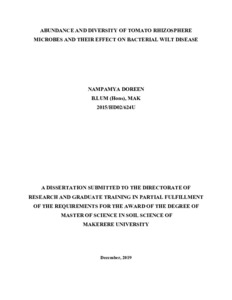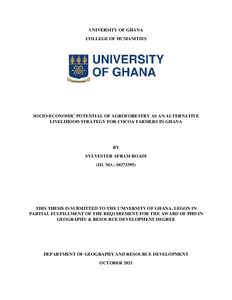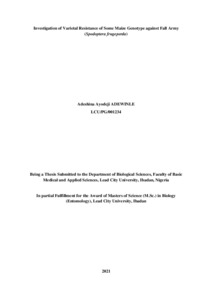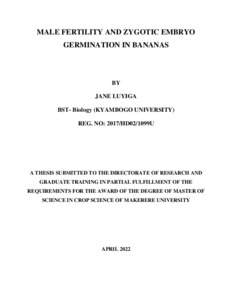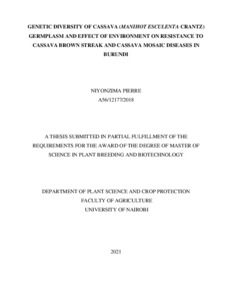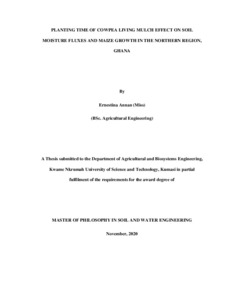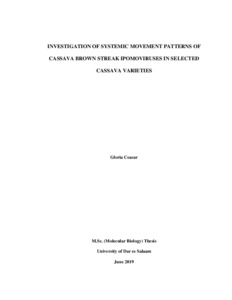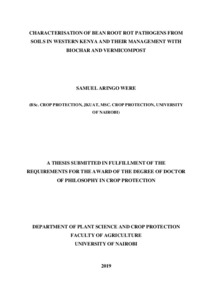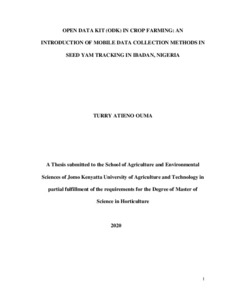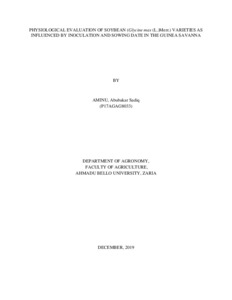Welcome to the International Institute of Tropical Agriculture Research Repository
Theses and Dissertations: Recent submissions
Now showing items 61-80 of 111
-
Soil fertility mapping and development of nutrient management zones in maize-based cropping system of the savanna zone of Nigeria
(Bayero University, 2019-07)There is a growing need for spatially continuous and quantitative soil information for improved farmers yields and environmental management. This study was aimed at mapping the spatial variability of soil properties with focus on delineating soil nutrient management zones (MZs) in a maize-based cropping system. Farmers’ fertilizer application rates were monitored in relation to the yield obtained. The study was conducted in Ikara, Soba, Doguwa, Bunkure, Faskari, Kankara, Malumfashi, Bakori, Kafur, ... -
Abundance and diversity of tomato rhizosphere microbes and their effect on bacterial wilt disease
(Makerere University, 2019-12)The use of land for agricultural production is always accompanied with changes in microbial diversity and emergency of new pathogens. Microbial imbalances and unevenness have enhanced multiplication of pathogens and proliferation of many soil borne diseases, which are tedious to control. Biocontrols are promising and environmentally friendly agents against such diseases. However, microbiome composition and land use management have been mentioned as core factors in effectiveness of biocontrols. ... -
Socio-economic potential of agroforestry as an alternative livelihood strategy for cocoa farmers in Ghana
(University of Ghana, 2021-10)Cocoa (Theobroma cacao) cultivation in Ghana is dominated by smallholder farming households most of whom derive the greater percentage of their incomes from the crop. Changes in climate in addition to inherent boom-and-bust cycles associated with cash cropping is reducing the yielding capacity of cocoa plots and, by extension, household incomes. Current research suggests that the integration of trees and other crops into cocoa plots has the potential to increase the resilience of these farms to ... -
Investigation of varietal resistance of some maize genotype against fall army (Spodoptera frugeperda)
(Lead City University, 2021)The fall armyworm (FAW) has recently invaded and established itself as a major maize pest in Africa, causing yield losses of up to a third of annual maize production. The current study assessed several elements of resistance to FAW larvae feeding of 48 maize hybrids developed by IITA scientists in the laboratory, screen house, and field. The arrest and feeding of FAW neonate larvae in no-choice and choice trials, the growth of larvae-pupae in laboratory circumstances, and plant damage in a field ... -
Male fertility and zygotic embryo germination in bananas
(Makerere University, 2022-04)Crop improvement through crossbreeding relies on the generation of new hybrids from seeds. Therefore, seed set and seed germination are key determining factors for a successful breeding program. In banana breeding, both seed set and seed germination are low, especially in triploid and tetraploid bananas. To improve germination, embryos are extracted from seeds and cultured in vitro. Seed set is determined by the quantity and viability of pollen for the male parents, or male fertility, and by the ... -
Factors influencing the decision of cassava farmers to sell or process roots in selected states of southwest, Nigeria
(2022-05)Cassava farmers are faced with the decision to either sell or process the roots of the crop. However, the factors affecting this decision are largely unknown. Three hundred and six cassava farmers were interviewed, with the objectives to (i) profile the socio-economic characteristics of farmers (ii) examine the price trend between January, 2019 to August, 2020, (iii) costs and returns of the farmers who sell roots and cassava products, (iv)profile the risks and mitigating strategies used by farmers ... -
Occurrence, abundance and distribution of nematodes of banana linked to altitude in selected banana production areas with focus on pathogenicity of Pratylenchus goodeyi in Kenya
(Kenyatta University, 2022-06)Banana (Musa spp.) is a popular fruit crop in Kenya, where it is largely cultivated by smallholder farmers. However, plant pathogens, such as plant parasitic nematodes, have been blamed for the fall in output (PPN). A survey of bananabased subsistence farming systems in Kenya's banana-growing counties was done with the objective to a) assess farmers' awareness regarding PPN, b) explore the variability regarding PPN species associated with banana genotypes in Kenya and if the prevalence and abundance ... -
Potential use of denitrifying bacteria in reduction of nitrogenous compounds in the effluent discharged into lake Victoria, Kenya
(University of Embu, 2022-04)Nutrient loading with nitrogen and phosphorus in receiving waters is an increasing concern worldwide. In Lake Victoria basin, the substantial inflow of nutrients has led to intensive eutrophication of the lake. This has negatively affected not only the economic but also aesthetic as well as ecological functions. Nitrogen cycle in the atmosphere is driven by symbiotic and free-living microorganisms, which reduces dinitrogen gas to bioavailable ammonia. Ammonia is oxidized completely by a two-step ... -
Improvements to cassava-maize intercropping systems in southern Nigeria
(ETH Zurich, 2021)Cassava-maize intercrop is a traditional and the most popular cassava-based cropping system in southern Nigeria where farmers allocate > 60% of their farmland to intercropping in a typical cropping season. Besides that the system is ecologically adapted to the region, it facilitates a quick recovery from food and cash shortages at planting seasons caused by seed and cash investments in farming operations in every cropping season, .i.e., through food and income generated from maize harvest ~ 3 to ... -
Genetic diversity of cassava (Manihot esculanta crantz) germplasm and effect of environment on resistance to Cassava Brown Streak and Cassava Mosaic Diseases in Burundi
(University of Nairobi, 2021)Cassava is an important cash crop for many small scale farmers in Burundi. Most small scale farmers use local landraces and though they have farmer preferred traits, their genetic diversity is unknown and marred by phenotypic susceptibility to Cassava Brown Streak Disease (CBSD) and Cassava Mosaic Disease (CMD). This limits future breeding programs to improve cassava production and resistance to diseases in Burundi. Due to this, disease tolerant genotypes from other countries were introduced to ... -
Morphological and molecular assessment of genetic diversity in some yam (dioscorea species) landreaces
(University of Ibadan, 2021-04)Yam (Dioscorea species) consist of about 600 species with only 6 species mostly used as food yam. New landraces have been cultivated across Sub-Saharan Africa with little or no information on their identities. However, information on these landraces will serve as a genetic tool for crop improvement. This study assesses the morphological and molecular characterisation of the newly collected yam landraces for genetic diversity.One hundred accessions, comprising Dioscorea rotundata (83), Dioscorea ... -
Production et valorisation des larves de mouche soldat noire, Hermetia illucens (Diptera : Stratiomydae)
(University of Dschang, 2021-06)La mouche soldat noire (MSN), Hermetia illucens est un insecte à métamorphose complète qui durant son stade larvaire s’alimente avec voracité sur divers types de substrats organiques tout en convertissant les composés azotés et les hydrates de carbones en biomasses larvaires hautement riches en protéines et en lipides alimentaires. Cette étude avait pour objectif d’élucider les processus biologiques clés qui ont lieux durant son cycle de développement et leurs applicabilités dans le recyclage des ... -
Planting time of cowpea living mulch effect on soil moisture fluxes and maize growth in the northern region Ghana
(University of Ghana, 2020-11)The Northern Region of Ghana is vulnerable to weather variability especially uneven rainfall distribution patterns. This compromises soil moisture availability for optimal crop growth. The objective of this study was to assess the effect of cowpea living mulch as a soil and water conservation measure on soil moisture fluxes and maize growth in the Northern Region of Ghana. Four different maize-cowpea intercrop systems were combined with three maize varieties in four different communities and their ... -
Investigation of systemic movement patterns of Cassava Brown Streak ipomoviruses in selected cassava varieties
(University of Dar es Salaam, 2019-06)Cassava is among the important food security crops in Sub Saharan Africa and a major staple food for more than 800 million people in the developing world. Cassava production in Africa which is more than half of the total world production is affected by viral diseases, one being Cassava Brown Streak Disease (CBSD) caused by two distinct species of Ipomoviruses namely; cassava brown streak virus and Ugandan cassava brown streak virus collectively called cassava brown streak ipomoviruses (CBSIs). ... -
Characterisation of bean root rot pathogens from soils in western Kenya and their management with Biochar and Vermicompost
(University of Nairobi, 2019) -
Open Data Kit (ODK) in crop farming: an introduction of mobile data collection methods in seed yam tracking in Ibadan, Nigeria
(Jomo Kenyatta University Of Agriculture And Technology, 2020)The purpose of this paper is to illustrate the importance of applying open-source technologies for mobile-based data collection for real-time tracking of seed yam (Dioscorea rotundata and Dioscorea alata) production. Seed yam data in Nigeria have been predominantly collected using field notebooks in the past, which were subsequently entered into a Microsoft Excel spreadsheet or Access database for analysis and reposition. Relevant areas of weakness within the current data systems include time delay ... -
Identification of end-users' preferences of a cassava product ("Gari") in Benue and Osun State, Nigeria
(Ladoke Akintola University of Technology, 2020-03)Breeding of improved cassava varieties has been concentrated on preferred characteristics by the farmers to the detriment of attributes preferred by other end-users which made the final product not generally acceptable by all the end users. This study aimed at identifying the preferred quality characteristics of gari/eba among farmers, processors, traders and consumers to help breeders to develop new improved cassava varieties that will meet the quality characteristics of good gari as preferred ... -
Effect of fertilizer combinations on soil chemical properties, growth and yield of cassava (Manihot esculenta Crantz) in Ogun State
(Federal University of Agriculture Abeokuta, 2021-05)Cassava (Manihot esculenta Crantz) is a heavy feeder crop that exploits large volume of soil for nutrients, hence the continuous cultivation of cassava result in nutrient depletion, unless adequate fertilizer input such as inorganic fertilizer is used. This necessitated testing the effect of eleven different fertilizer types: Control (no fertilizer), recommended rate of nitrogen (N), phosphorus (P), potassium (K), half recommended rate of N, P, K, NPK + Micro-nutrients, NP, NK, PK, half N + P, K, ... -
Physiological evaluation of soybean (Glycine max (L.) Merr.) varieties as influenced by inoculation and sowing date in the Guinea Savanna
(Ahmadu Bello University, 2019-12)A field trial was conducted during the 2018 Rainy Season at the Research Field of International Institute of Tropical Agriculture, University farm of Ahmadu Bello University, Zaria at Samaru in the Northern Guinea Savanna and International Institute of Tropical Agriculture Research farm, Kubwa Abuja in the Southern Guinea Savanna of Nigeria. The treatments consisted of four varieties of soybean (TGx 1904-6F, TGx 1951-3F, TGx 1955-4F and Sambaiba), two sowing dates (late June and early July) and ... -
Predicting biochar production and carbon sequestration for soil productivity in eastern Uganda
(Makerere University, 2019-12)Biochar, a product of biomass gasification is used to sequester carbon in soils for long periods of time and intensification of agricultural productivity. Crop residues are an important source of biomass for biochar production but availability in smallholder farming systems across Sub Saharan Africa (SSA) is unknown due to the cost and labor involved in obtaining related empirical data. The study presented here was carried out in Pallisa district, Uganda and (1) mapped crop residue yields and ...


